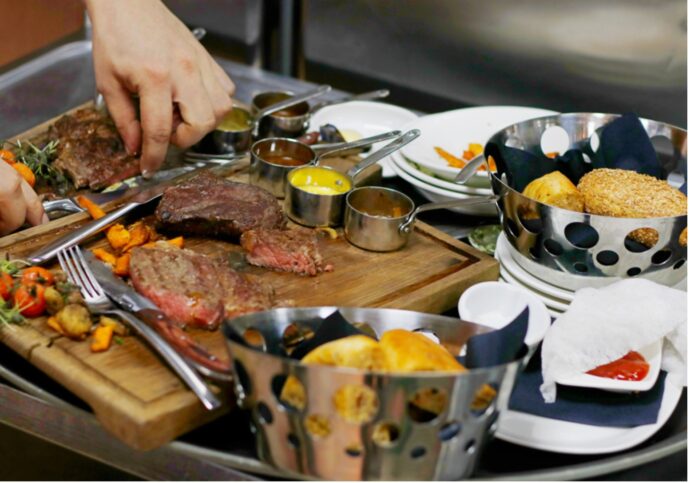One thing that most restaurants have in common is they waste more food than their chefs and kitchen managers would probably like to admit. In fact, studies show that as much as 10 percent of all food that restaurants purchase goes to waste.
That’s not good for business. It’s not good for the planet. And it’s not good for our food supply and distribution systems. If your restaurant’s food waste is out of control, it’s time to attack the problem head on. We look at some common food waste issues that restaurants experience and some common-sense, sustainable solutions for tackling them.

Problem: Your restaurant doesn’t track food waste.
Many restaurants do not have a robust system for tracking how much food they waste. Metrics like garbage bag use or weighing your trash might seem to offer an easy answer. However, they don’t account for the number of different types of waste that usually go into the same can.
Solution: Use a food waste tracking sheet.
A food waste log is a basic but effective way to track pre-consumer food waste. Keep one on deck at all times in the kitchen. And make sure staff know to use it when they have to throw ingredients away. Enter data from your waste log into a spreadsheet tracker or kitchen management software. And examine these numbers regularly to spot potential problems.
Solution: Separate your waste into bags and weigh them individually.
Some restaurants might be able to separate their waste into different bags, which makes it easier to break down waste by category and weigh them individually. If the idea sounds intimidating, start with two cans lined with recycled eco-friendly trash bags — one for food waste and one for everything else.
Standard 55-gallon trash bags for commercial kitchens are available in a variety of colors that make it relatively simple to separate waste streams into two or more cans.
Problem: Guests are leaving their meals unfinished.
How many times have you seen half a plate of food or more go into the garbage because a guest didn’t finish it? There are steps you can take to curb this source of food waste. Unfinished meals are another metric that can be tough to quantify, so ask the front of house staff to keep an eye out and observe what gets thrown away most frequently.
Solution: Find out if specific menu items are thrown away more than others.
If guests are often leaving a certain item unfinished, it’s a sign that you might need to re-evaluate something. Is the kitchen preparing the recipe incorrectly? Does the recipe need to be changed? Has the quality of the ingredients declined? These problems may not show up in numerical metrics, so you might need to conduct some qualitative research in conversations with guests and FOH staff.
Solution: Think about reducing portion sizes.
First, check to make sure that your kitchen staff is actually preparing and serving the portion sizes the recipe calls for. If they are, think about whether it might be time to reduce portion sizes on items that guests frequently don’t finish. Many restaurants serve larger-than-recommended portions anyway, so cutting back might actually just mean serving a normal amount of food!

Problem: Food is expiring before you use it.
If you’re losing a lot of food to expiration, the pattern should be easy to discern on your food waste tracking sheets. You can approach this problem in a few different ways, and it might be necessary to try more than one.
Solution: Rethink your approach to demand forecasting.
Almost all restaurants do some kind of demand forecasting, whether formal or informal, and refining the accuracy of that forecast is critical for avoiding waste. Frequent overstocks and expired ingredients can indicate that it might be appropriate to order those ingredients in smaller amounts.
Solution: Work with your food supplier to troubleshoot issues.
Call your wholesale food supplier directly if you’re frequently receiving food from them that’s about to go bad. Your supplier should be willing to work with you to solve this problem, and if they won’t, it’s worth shopping around for another supplier that will.
Solution: Donate non-perishable food to local hunger relief organizations.
If you know that you won’t use food before it goes out of date, make plans to donate it to a hunger relief organization, such as a food pantry or food recovery group. Note, however, that most organizations don’t accept expired food, so you’ll need to have someone on top of pantry management to ensure that food gets donated in time.
Problem: Prepped food isn’t getting used in time.
Prepped food is another source of restaurant food waste. Once food is prepped, it has to be used within a certain time or be thrown away. If prepped food often gets thrown away, use the following tips to find out what’s wrong.
Solution: Track which foods you’re overpreparing.
Your prep lists might need to be recalibrated if you’re consistently throwing away the same prepped foods. Kitchen staff should note prepped food that gets thrown away on the kitchen waste sheet. Review these numbers regularly to determine if you need less (or more) of certain items prepped.
Solution: Make sure your kitchen staff is following first in, first out (FIFO).
Most kitchens use the first in, first out (FIFO) method to keep food dates organized and reduce waste. The principle is simple: The oldest or first-prepped food in the cooler needs to be used before food that was prepped more recently. If items have expiration dates, use the ones that will expire sooner before the ones whose dates are farther away. Make sure that the expiration periods for various prepped foods are also clearly posted to keep them fresh in everyone’s mind.
Problem: Your kitchen often has to remake orders.
Refiring tickets is frustrating and wasteful for any kitchen. It interrupts the workflow, raises the stress level, upsets guests and wastes ingredients. If refires are a frequent event in your kitchen, now is the time to get them under control.
Solution: Improve your training practices on problem recipes.
Some staff members might need extra training to get a challenging recipe right. Focus on key areas and ask what fundamental skills someone might need help with if, for example, their sauces are the wrong consistency or steaks are often over temperature. This is also a great opportunity for senior kitchen staff to mentor junior ones and help them sharpen their skills.

Above all, remember that fighting restaurant food waste is a team effort that needs all hands on deck. When everyone from line cooks to head chefs to kitchen managers works together, any restaurant can make big gains in sustainability.





